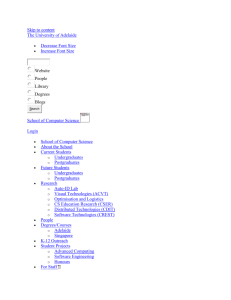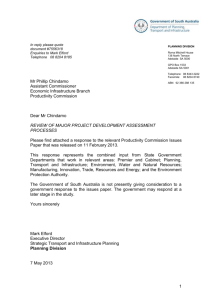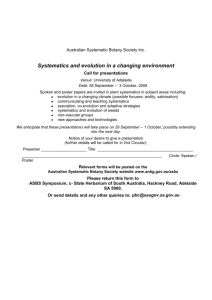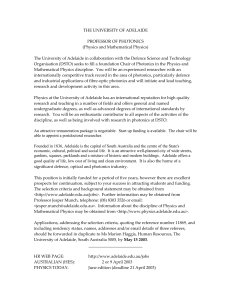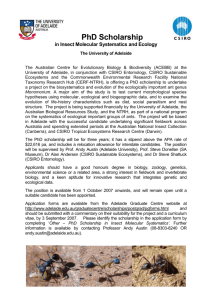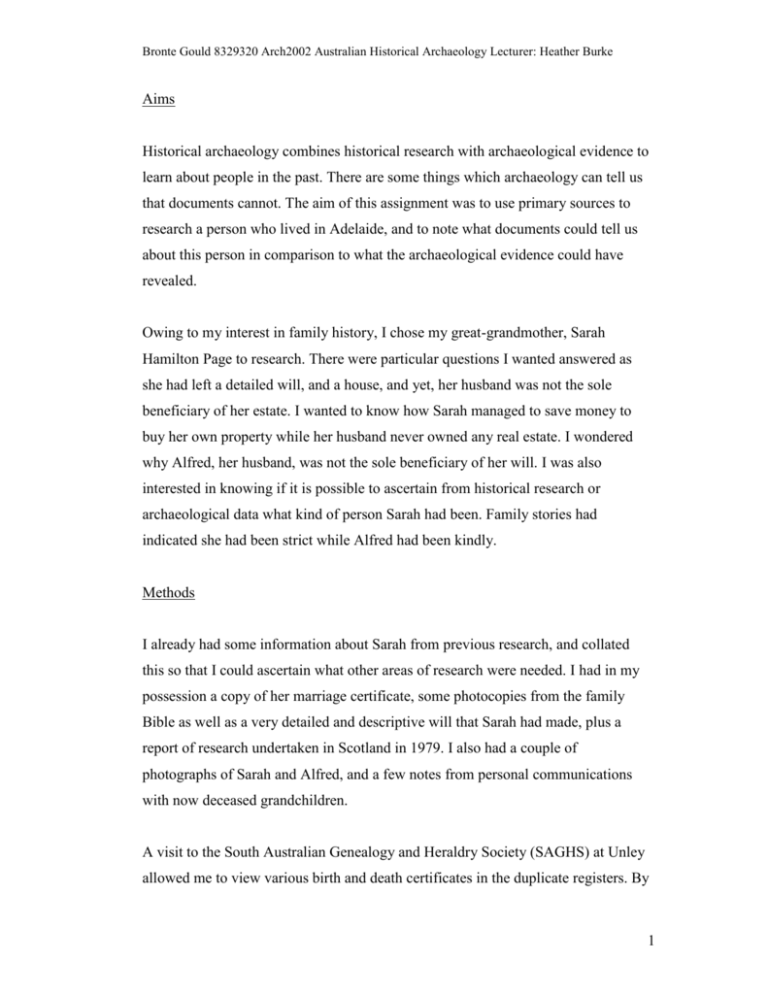
Bronte Gould 8329320 Arch2002 Australian Historical Archaeology Lecturer: Heather Burke
Aims
Historical archaeology combines historical research with archaeological evidence to
learn about people in the past. There are some things which archaeology can tell us
that documents cannot. The aim of this assignment was to use primary sources to
research a person who lived in Adelaide, and to note what documents could tell us
about this person in comparison to what the archaeological evidence could have
revealed.
Owing to my interest in family history, I chose my great-grandmother, Sarah
Hamilton Page to research. There were particular questions I wanted answered as
she had left a detailed will, and a house, and yet, her husband was not the sole
beneficiary of her estate. I wanted to know how Sarah managed to save money to
buy her own property while her husband never owned any real estate. I wondered
why Alfred, her husband, was not the sole beneficiary of her will. I was also
interested in knowing if it is possible to ascertain from historical research or
archaeological data what kind of person Sarah had been. Family stories had
indicated she had been strict while Alfred had been kindly.
Methods
I already had some information about Sarah from previous research, and collated
this so that I could ascertain what other areas of research were needed. I had in my
possession a copy of her marriage certificate, some photocopies from the family
Bible as well as a very detailed and descriptive will that Sarah had made, plus a
report of research undertaken in Scotland in 1979. I also had a couple of
photographs of Sarah and Alfred, and a few notes from personal communications
with now deceased grandchildren.
A visit to the South Australian Genealogy and Heraldry Society (SAGHS) at Unley
allowed me to view various birth and death certificates in the duplicate registers. By
1
Bronte Gould 8329320 Arch2002 Australian Historical Archaeology Lecturer: Heather Burke
doing so, I was able to find out where the family had been living at the time of the
birth or death of their children, as well as Alfred Page’s occupation. I also checked
the index to the South Australian Police Gazette and found several references to
Alfred Page. As well, the Adelaide Hospital Admissions Register index was checked
and entries for several Page family members, including Sarah and Alfred, were
noted.
From all of this information, I drew up a table including details of year, event and
residence (see Appendix A). This enabled me at a glance to see what areas I needed
to investigate further, and was also a time line of Sarah’s life.
I then visited the State Library of South Australia (SLSA) to check the South
Australian Directories. These gave me additional places of residence for either
Alfred Page or Sarah Page. I was surprised to find several entries that did have
Sarah’s name listed separately in several cases as a boarding house keeper.
The Lands Titles Office (Land Services Group) in Grenfell Street was then visited.
After initial instruction on how to use the Historic Records on their computer, I was
able to locate several references to land dealings that Sarah had. These concerned
property at her last place of residence, Kent Road, Keswick, and for which I had
been given a photograph showing the front of the house with Alfred Page sitting on
the veranda (Certificate of Titles 686/18, 915/86 and 915/87 - see Appendix B). I
ordered in some Memorandums of Transfer to find out details of the property sales.
This necessitated a further visit at a later time to the Lands Titles Office as the
documents needed to come from storage off-site.
Knowing where Sarah had lived, a check of the Adelaide City Council Archives
revealed details about rates for some of the properties (see Appendix C). Keswick,
though, was not in the Adelaide City Council area so I contacted the West Torrens
City Council to try and access the Assessment Books for Kent Road, Keswick.
Instead, I was told the books had been deposited at State Records and were awaiting
2
Bronte Gould 8329320 Arch2002 Australian Historical Archaeology Lecturer: Heather Burke
cataloguing. However, upon checking State Records, they could find no record of
these particular documents and suggested I contact the Council again. As time was
short, I was unable to follow this up.
Visiting State Records revealed some additional information regarding Alfred Page
in the South Australian Police. I also checked for the Succession Duties File for
Sarah Page, but found that after 1919 they were closed to public inspection. This is a
pity as they can provide valuable information in addition to the will. However, as
Sarah’s will was extremely descriptive, it is possible there was nothing more to gain
from this file (see Appendix D).
Another visit to the Lands Title Office revealed Sarah had owned another block of
land at Richmond in 1898 (Certificate of Title 641/27 - see Appendix B). Further
Memorandums of Transfer were ordered to gain additional information. I then had to
revisit the State Library as I had discovered that in the front of the South Australian
Directories for some years, streets were listed with the names of the residents. I was
able to obtain the name and occupations of neighbours for the Kent Road house and
also for Sarah’s residence at Landrowna Terrace, Victoria Square East.
I checked the Land Services Group website to obtain a plan map for the blocks of
land that Sarah had lived on at Keswick (see Appendix E). A later visit to the
Keswick address to view the house found it had been replaced by units. I also
checked Landrowna Terrace on-line, and at the library, and discovered this had been
demolished in 1923 and replaced by a Government building (SLSA; Pikusa
1986:107).
However, there was one feature that was still standing and that was the headstone in
West Terrace Cemetery. This I visited but the public information screen was out of
order and I was unable to obtain a print of details of Sarah’s burial. However, the
headstone is still there and I photographed and measured this (see Appendix F). On a
3
Bronte Gould 8329320 Arch2002 Australian Historical Archaeology Lecturer: Heather Burke
subsequent visit I was able to obtain a print-out of details of her burial plot from the
public information screen.
Another visit to the Genealogy Society was required to view the West Terrace
Cemetery Nominal Lessees records, which revealed Sarah had purchased a double
burial plot in 1918. This coincided with the death of her youngest son who was
killed, age 16, in October 1917 in the First World War in Belgium (CWGC; NAA).
Finally, I re-visited the Lands Titles Office to view the Memorandum of Title for the
block Sarah purchased in 1898. This was the final research trip owing to a lack of
time.
Results
Sarah Hamilton Fairlie had been born at Crosshill Village, Ayrshire, Scotland in
1848 the daughter of John Farrell and Isabella Hamilton (Pitcairn 1979:4). At the
time of Isabella Hamilton’s death, it was noted her surname had changed to Fairley
(Pitcairn 1979:2). Sarah came to Adelaide via Melbourne in 1869 with her father,
stepmother, some siblings and her half-siblings per the SS Great Britain to
Melbourne, and from there, via the Aldinga, to Adelaide (SLSA 1987 – see
Appendix G). According to Sarah’s obituary, her father, John, was appointed as
Head Gardener to Sir James Fergusson, Governor of South Australia (The Chronicle
29 May 1920:38 – see Appendix H). He had apparently worked for Governor
Fergusson in Scotland. Prior to this, he had been a weaver in Crosshill Village,
Ayrshire. It was also noted from various Scottish census records that he was Irish
(Pitcairn 1979:3).
Sarah married Alfred Page, a cooper, on 10th April 1875 at Cypress House,
Pennington Terrace, North Adelaide (SA Marriage Certificate – see Appendix I).
Witnesses were John Fairlie, gardener (Sarah’s father) and Isabella Fairlie (Sarah’s
4
Bronte Gould 8329320 Arch2002 Australian Historical Archaeology Lecturer: Heather Burke
sister). There were 14 children of the marriage, including the last child who was
actually an illegitimate grandchild raised by Sarah and Alfred as their own son.
The following shows their children with places and dates of birth.
Mary Crispina (Pina)
Isabella Fairlie
Ada Victoria
Bertha Jane
Alfred Hamilton
Laurenza
Violet Williamson
James Dudley Campbell
Minnie Mabel
Archie Blantire
Mabel Sarah Adelaide Hamilton
Claude Frederick
Oriel Edith
Harold Williamson (also known
as Harold Keith and Eddie)
Tam O’Shanter Street, Adelaide
Charles Street, Adelaide
Richmond
Richmond
Halifax Street, Adelaide
Chancery Lane, Adelaide
Morphett Street, Adelaide
Unknown
King William Street, Adelaide
King William Street, Adelaide
Victoria Square, Adelaide
Flinders Street, Adelaide
Flinders Street, Adelaide
Lying In Department, Destitute
Asylum, Adelaide
17 August 1875
20 February 1877
10 January 1879
17 December 1879
29 November 1880
23 June 1882
5 May 1885
c1887 – not registered
19 January 1890
19 January 1890
19 June 1892
6 November 1894
8 October 1896
22 March 1901
Table 1: Names, places and dates of birth of children of Alfred and Sarah Page.
Information obtained from various South Australian birth and death certificates, and
the Family Bible.
Following their marriage, Sarah and Alfred lived in inner Adelaide, apart from 1879
when the family lived at nearby Richmond and Maylands (Boothby). The house they
occupied in Carrington Street, Adelaide was valued at £24, and they paid £1 14s in
rates on 30 July 1878. In Hindmarsh Square, the house had a value of £40 for which
they paid £2 16s 8d in rates on 15 August 1878 (Adelaide City Council Archives). It
wasn’t until much later, around 1914 that they moved to Kent Road, Keswick (Sands
& McDougall). During their time in Adelaide it appears they moved regularly from
various street addresses, but there was some stability from 1901 to at least 1912
when they were listed as at No. 4 Landrowna Terrace, Victoria Square East (Sands
& McDougall). Sarah had been listed as at No. 8 Landrowna Terrace, Victoria
Square East in 1884 as having a boarding house (Boothby). This latter address
revealed eleven terrace houses, ten of which were boarding houses (see Appendix J).
Eight of these boarding houses were run by married women - there was no indication
as to whether these women were still married at that time, separated or widowed.
5
Bronte Gould 8329320 Arch2002 Australian Historical Archaeology Lecturer: Heather Burke
Running a boarding house was probably a way to supplement a meagre income and
is perhaps how Sarah had managed to save to buy her land. An inheritance is most
unlikely as neither her father, John Fairlie, who died in 1879 (SA Death Certificate),
left a will, nor her step-mother Rebecca Fairlie (died 1906), who had been
institutionalized in the Parkside Lunatic Asylum for 23 years (SRSA GRG 1/44).
The Citizen Rolls for the Adelaide City Council show Alfred had a shop in Flinders
Street in 1897-98 and, the following year, was listed as living in Nelson Street
(Adelaide City Council Archives). His obituary notes he did have a coopering
business in Nelson Street (The Chronicle 3 July 1920:13 – see Appendix K).
Figure 1: Landrowna Terrace, Victoria Square East. (Pikusa 1986:107).
A plan of the layout for Landrowna Terrace has not been found other than the
following outline.
6
Bronte Gould 8329320 Arch2002 Australian Historical Archaeology Lecturer: Heather Burke
Figure 2: Placement of Landrowna Terrace opposite Victoria Square from Smith
City Survey 1880 (Pikusa 1986:107).
Surprisingly, in March 1884, Alfred Page was charged with assaulting and beating
his wife and served seven days in the Adelaide Gaol in lieu of paying a 25 shillings
fine (SRSA GRS/2749 and GRS24/14). Later, in July, he was reported as a missing
person and his description was printed in the South Australian Police Gazette (SRSA
GRG5/50). This was in contrast to accounts from grandchildren, who had indicated
that Alfred was a kindly man and Sarah had been very strict (Chapman 1981; Siebert
1979). About a week later, Alfred was apprehended near Hamley Bridge. However,
as there were further children to the marriage, a long term separation appears to have
not taken place, nor were there any further incidents recorded.
Figure 3: South Australian Police Gazette, 9 July 1884 (SRSA GRG 5/50 1884:133)
In March 1884 Sarah and Alfred’s infant son, Laurenza died (SA Death Certificate).
His death was noted in the Family Bible and a verse written, but the handwriting was
not Sarah’s (see Appendix L). Laurenza was memorialized retrospectively on
7
Bronte Gould 8329320 Arch2002 Australian Historical Archaeology Lecturer: Heather Burke
Sarah’s headstone in West Terrace Cemetery. It does seem strange, though, that
another infant daughter, Bertha Jane, who died in March 1880 (SA Death
Certificate) was never mentioned, either in the Bible or on the headstone.
Sarah was admitted to the Adelaide Hospital in December 1887 for seven days and
gave her religion as Presbyterian (SAGHS). Several hospital admissions for Alfred
were also noted and he gave his religion as Baptist (SAGHS).
In 1890 Sarah gave birth to non-identical twins, Archie and Minnie Mabel but just
before Christmas of that year, Minnie Mabel died of whooping cough (SA Death
Certificate). Sarah wrote the following in her Bible:
December 21s 1890
darling Minnie Mable Page
her bright blue eyes her flaxing hair
her voice I loved to hear
all all has gone from me
but I Would not call her back
again
in this cold world of sin
for Jesus Knew My little
sweet, wee flour
Was better thear
With him. At rest
SP
(Family Bible – see Appendix L).
“At rest” appears to have been added by someone else as is not in the same
handwriting. Note also some spelling errors.
A photograph of Minnie Mabel was mentioned in Sarah’s will, but despite this,
Minnie Mabel was not memorialized on the headstone either. There were several
more children to follow, including Sarah’s grandson born at the Destitute Asylum to
daughter Violet in 1901 when Violet was 15 years old (SRSA GRG28/15). Alfred
and Sarah raised this child as their own, and it is unlikely that he ever knew that they
were his grandparents.
8
Bronte Gould 8329320 Arch2002 Australian Historical Archaeology Lecturer: Heather Burke
In 1898 Sarah had purchased a small block of land at Ellenville (now Richmond)
and paid £33 (Certificate of Title 641/27). She and Alfred were living at Nelson
Street in the city at that time. By 1901 they were listed as at No. 4 Landrowna
Terrace, Victoria Square (Boothby). That year, Alfred Page had the misfortune to
find one of his lodgers had hung himself in the bathroom. Upon finding the door
locked, Alfred peered through the window and discovered the dead man.
Presumably the bathroom was at the back of the terraced houses. The report to the
Coroner confirms they had kept a boarding house (SRSA GRG1/44).
In 1902, Sarah also purchased Lot 285 of Keswick (which had originally been
subdivided in 1882) paying £12 (Memorandum of Transfer T375584). In June 1906,
these two blocks were sold for the sum of £61 (Memorandum of Transfer 437625),
but in 1911 Sarah purchased lot 285 Keswick again, and also lot 318 for the sum of
£70 (Memorandum of Transfer 528928). It is unknown if a house had already been
built on this block. Lot 318 fronted Chatham Street and backed onto lot 285 which in
turn fronted Kent Road (see Appendix E). In 1912, a portion of lot 318 was sold to
her son, Archie Page for £25 (Memorandum of Transfer 561535) and, from the
amended plan, this left a small laneway at the side of this block. Her will stated she
had a horse and carriage, so it is possible this may have been a back entrance into
her property with a stable built at the back of lot 318. By October 1913, Sarah had
purchased, for £25, from Archie Page the portion of lot 318 she had previously sold
to him (Memorandum of Transfer 600496). There were no further land dealings
recorded in her name after this date.
The 1913 directory indicates Sarah was living at Keswick, although the 1914
directory also listed her as at Moonta Street, off Grote Street, where Alfred was
listed (Sands & McDougall). On 4 September 1916, with the consent of his parents,
Alfred and Sarah, Eddie enlisted in the 48th Battalion (NAA – see Appendix M), and
he was later killed at the Battle of Passchendaele in Belgium in October 1917 aged
16 years (NAA; CWGC). This must have been a devastating blow for both Sarah
9
Bronte Gould 8329320 Arch2002 Australian Historical Archaeology Lecturer: Heather Burke
and Alfred, and it is believed they never quite recovered from their loss (Siebert
1979; Chapman 1981). This was probably the catalyst for Sarah to purchase a lease
at West Terrace Cemetery in 1917 for a double plot (West Terrace Cemetery). A
headstone was erected memorializing Eddie below his brother Laurenza with Sarah
and Alfred’s names later added. Several short verses and motifs or symbols appear
on the headstone. The inscription reads:
In
Loving Memory
of
MY DEAR SON
LAURENZA PAGE
WHO DIED IN 1882.
[FLAGS SYMBOL]
A TRIBUTE OF LOVE AND HOOR
TO MY DEAR SON
PRIVATE H. K. PAGE
“EDDIE”
LATE 48TH BATTALION
KILLED IN ACTION IN THE BATTLE OF PASSCHENDAELE
OCT. 12 1917
-----------“BEHIND THE SHADOWS STANDETH GOD”
-----------ALSO
SARAH HAMILTON PAGE
BORN AT AYRSHIRE, SCOTLAND 1851
DIED MAY 24TH 1920
[STAR SYMBOL]
PEACE, PERFECT PEACE
ALFRED PAGE
BELOVED HUSBAND OF THE ABOVE
BORN AT ADELAIDE 1849
DIED SUDDENLY JUNE 20TH 1920
-----------IN THE MIDST OF LIFE WE ARE IN DEATH
(West Terrace Cemetery, Plan 3, Row 19, Site 44.)
10
Bronte Gould 8329320 Arch2002 Australian Historical Archaeology Lecturer: Heather Burke
While the house at Kent Road no longer exists, a photograph shows Alfred sitting on
the front verandah with several wooden barrels used as plant pots. There is also
evidence of a rudimentary front garden. The will refers to several areas within the
house – the back verandah where her cockatoo in a cage was kept; the sitting room,
kitchen and hall. A typical plan of a symmetrical house built in 1898 appears below
and the Kent Road house may have resembled this layout. It is unknown when the
house was built.
Figure 4: Symmetrical house plan built in 1898. (Persse
and Rose 1983:7).
Figure 4: House at 24 Kent Road, Keswick (now 26 Kent Road) with Alfred Page
seen sitting on front verandah. Photograph per the late Dudley Page.
11
Bronte Gould 8329320 Arch2002 Australian Historical Archaeology Lecturer: Heather Burke
Discussion
Archaeologist Charles Orser noted that there was a “clear overlap” existing
“between text-aided archaeology and historical archaeology” (2004:5). Historical
research complements archaeological data and vice versa.
A great deal of information about Sarah and her family has been obtained from
documentary sources. Most of these documents were official records. If Sarah had
not been able to afford to buy her property and obtain some independence from her
husband in the records, it is more than likely she would have remained in the shadow
of her husband and poorly documented. Women during the nineteenth century and
the early twentieth century were usually dominated by their husbands, unless they
came from wealthy families or married into wealth. It was also unusual for a married
woman at that time to have owned property independent of her husband.
Personal documents can give an insight into what a person’s character was like and
this is reflected in the Bible verse that Sarah wrote on the death of her daughter
Minnie Mabel, as well as the verses and symbols on her headstone. It is not clear
why infant daughter Bertha Jane was never recorded in the family Bible, nor on the
headstone. If it were not for her birth and death registrations, she would have
remained unknown. Perhaps gender was an influencing factor as to whose names
were recorded on the headstone.
Material assemblage from a house can give an even greater insight into the daily life
and activity of the family as well as giving an indication of a person or family’s
station in life. Sarah’s will was particularly descriptive, but the items mentioned
generally reflect her pieces of furniture, photographs and special pieces of crockery
and glassware. She had willed her kitchen dresser and dishes to her daughter Ada,
but there is no record of what type of dishes. If some of these were available, they
could be used to ascertain what quality the dishes were, which may reflect her
12
Bronte Gould 8329320 Arch2002 Australian Historical Archaeology Lecturer: Heather Burke
buying power and perhaps her status in life at the time. This is where the
archaeological record could have provided additional information to complete the
record of Sarah.
It is known from her will that Sarah had a horse, cart and carriage. The horse would
have had to have been stabled somewhere on the property. The documents do not
specify the exact location, but archaeological evidence could have confirmed this. In
the absence of material remains, certain assumptions can be made but not confirmed
unless specific documentary evidence should arise which identifies the site.
In addition, archaeological evidence can give insights into the food eaten by the
household from analysis of food remains, or the examination of discarded bones to
determine cuts of meat. This too can be correlated to a person’s financial
circumstances as to whether they could afford more expensive food.
Relying on the testimony of the grandchildren can reveal some flaws. Both
grandchildren would have been aged ten and four at the time of their grandparent’s
deaths, and were probably impressionable. They may have perceived their
grandmother as strict, but she may have needed to be the disciplinarian. It could also
have been that at the time of their recollection, she may already have been unwell. It
may also have been that the four year old remembered one incident in her life and
the remainder of her recollections may have been ‘coloured’ by other family
members over the years. A clue to Alfred’s character is contained in Sarah’s will,
when she instructed her sons: ‘with regards to their father to see that the money left
to him is not wasted in any way but to be given to him as they think fit’.
It is not known when the house in Kent Road, Keswick was built, but the photograph
provides some architectural clues (see Appendix N). It can be seen that the front was
symmetrical with a bullnose verandah and iron lacework. The iron roof had gablets
with louvres at the top to allow air to circulate. This type of roof was built from 1905
and 1918 (Persse and Rose 1983:150). There are finials or decorative pieces which
13
Bronte Gould 8329320 Arch2002 Australian Historical Archaeology Lecturer: Heather Burke
were popular from 1900 to 1911 (Persse and Rose 1983:155). Attempts at a garden
are evident. An arch can be seen and possibly plantings of some rose bushes. There
is a garden tap which indicates water had been available to the property and possibly
inside. Alfred Page can be seen sitting on the verandah near several barrels that are
used as planter tubs, and these may be evidence of his work as a cooper. Most
probably the house was built between 1905 and 1913. The Assessment Books, if
they were available, could have assisted in the identification of the year it was built.
`
The grave at West Terrace Cemetery was located in the Plan Three section, Row 19,
plot 44. This is not far from West Terrace and the headstone faces east. The
headstone is a 165 centimetre tall sandstone tablet which has been centred on the
double plot. Iron bars with decorative finial topped iron posts demarcate the grave,
providing a border or barrier to people or animals (Department of Environment and
Planning 1983:14). There are several motifs and these can provide further
information. The top of the stone is decorated with a scallop shape and below these
shapes are images of flowers and a dove bearing an olive branch. This is generally a
symbol of peace (Department of Envirnoment and Planning 1983:13).
Above Eddie’s name are two crossed flags – the Union Jack and the Australian Flag.
These have been interpreted as indicative of the ties between England and Australia.
Australia sent many troops to Europe during the First World War to support the
British in their campaign. The flags may also represent Eddie’s heritage which was
both Scottish and English, as well as being Australian by birth.
Below Sarah’s name is an unusual symbol which at first glance appears similar to a
Star of David, enclosed in a double circle with decorations top and bottom
resembling the shape of the top of the headstone. While the star appears to be a
Jewish symbol, Sarah was known to be Presbyterian. There may have been writing
within the double circle but this has either worn off or is pitmarks in the sandstone.
14
Bronte Gould 8329320 Arch2002 Australian Historical Archaeology Lecturer: Heather Burke
Conclusion
Research of documentary sources has provided an outline of Sarah Hamilton Page’s
life and that of her husband and children. It is most probable Sarah saved her money
from her boarding houses. An inheritance is most unlikely. The documents appear to
indicate she was a resourceful woman who strived to improve her lot in life, and was
probably had the more dominant personality compared than her husband.
The only archaeological feature and therefore tangible evidence of Sarah’s life
remaining is her headstone in West Terrace Cemetery complete with its verses and
symbols. The house she owned had been demolished and replaced by units.
Something about her personality and character has been gained from the documents
and enriched by this archaeological source.
The research highlights the lack of records for women and children at the time. Had
Sarah not purchased property, there would have been few records available about
her. Her obituary dealt more about her father than her and referred to her daughters
by their married names than their own. Females’ lives were connected to their
husbands and therefore they became invisible. At the same time, men of the working
classes were also generally missing from the records.
As a process, researching the life of a person who lived in Adelaide highlighted the
need to be organized and meticulous. Time was imperative as a deadline had to be
met, yet many of the record repositories required to be visited several times
dependent upon the research findings. There is no centralization of records which
increased travel times, and some had associated costs for copying of documents.
WORD COUNT: 4278
15
Bronte Gould 8329320 Arch2002 Australian Historical Archaeology Lecturer: Heather Burke
REFERENCES
Primary Sources
Adelaide City Council Archives. City Treasurer’s Department (C5) Assessment
Book (S34) Volume 25 1878.
Adelaide City Council Archives. City Treasurer’s Department (C5) Assessment
Book (S34) Volume 27 1880.
Adelaide City Council Archives. City Treasurer’s Department (C5) Assessment
Book (S34) 1897-1898.
Adelaide City Council Archives. City Treasurer’s Department (C5) Assessment
Book (S34) 1899-1900.
Adelaide City Council Archives. City Treasurer’s Department (C5) Assessment
Book (S34) 1900-1901.
Adelaide City Council Archives. City Treasurer’s Department (C5) Assessment
Book (S34) 1901-1902.
Adelaide City Council Archives. City Treasurer’s Department (C5) Assessment
Book (S34) 1902-1903.
Adelaide City Council Archives. City Treasurer’s Department (C5) Assessment
Book (S34) 1903-1904.
Adelaide City Council Archives. Corporation of the City of Adelaide (C40)
Citizens’ Rolls (855) Item 21 1897-98.
Adelaide City Council Archives. Corporation of the City of Adelaide (C40)
Citizens’ Rolls (855) Item 22 1898-99.
Adelaide City Council Archives. Corporation of the City of Adelaide (C40)
Citizens’ Rolls (855) Item 23 1899-1900.
Adelaide City Council Archives. Corporation of the City of Adelaide (C40)
Citizens’ Rolls (855) Item 24 1900-01.
Adelaide City Council Archives. Corporation of the City of Adelaide (C40)
Citizens’ Rolls (855) Item 25 1901-02.
Adelaide City Council Archives. Corporation of the City of Adelaide (C40)
Citizens’ Rolls (855) Item 26 1902-03.
16
Bronte Gould 8329320 Arch2002 Australian Historical Archaeology Lecturer: Heather Burke
Adelaide City Council Archives. Corporation of the City of Adelaide (C40)
Citizens’ Rolls (855) Item 27 1903-04.
Boothby, J. 1873-1883 The Adelaide Almanac and Directory for South Australia.
Adelaide: J Williams. [Directories per each year to 1883]
Chapman, V. M., granddaughter, personal communication 1981.
Family Bible, photocopied pages, originally in possession of the late Dudley Page.
Land Services Group, Certificate of Title, 686/18 Sarah Page.
Land Services Group, Certificate of Title, 915/87 Sarah Hamilton Page .
Land Services Group, Certificate of Title, 915/86 Archie Blantyre Page .
Land Services Group, Certificate of Title, 641/27 Sarah Page.
Land Services Group, Memorandum of Transfer T375584, 1902.
Land Services Group, Memorandum of Transfer 437625, 1906.
Land Services Group, Memorandum of Transfer 528928, 1911.
Land Services Group, Memorandum of Transfer 600496, 1913.
Land Services Group, Memorandum of Transfer 561535, 1912.
Land Services Group, Transmission Application 758262, 1920.
Land Services Group, Keswick, Deposited Plan, Plan No.: 1288 D1288, sheet1:
rl070023.tif. Retrieved 31 March 2009 from http://www.landservices.sa.gov.au/
National Archives of Australia, World War I Personnel Service Records; B2455,
PAGE Harold Keith : Service Number - 3486 : Place of Birth - Adelaide SA : Place
of Enlistment - Adelaide SA : Next of Kin - (Mother) PAGE Sarah Hamilton, 19141920.
Photograph – Sarah Hamilton Page, original in possession of the late Dudley Page.
Photograph – Kent Road, Keswick residence with Alfred Page, original in
possession of the late Dudley Page.
Pitcairn, S., Report on research findings on the Fairley family dated 3 October 1979.
SAGHS, no date, Index to South Australian Police Gazettes, Unley:South Australian
Genealogy and Heraldry Society.
17
Bronte Gould 8329320 Arch2002 Australian Historical Archaeology Lecturer: Heather Burke
Sands & McDougall. 1884-1941 Sands and McDougall’s South Australian
Directory 1884-1941. Adelaide: Sands & McDougall.
Siebert, S., granddaughter, personal communication 1979.
South Australian Birth Certificate, Ada Victoria Page 10 January 1879, Adelaide
district, copy in possession of Bronte Gould.
South Australian Birth Certificate, Alfred Hamilton Page 29 November 1880,
Adelaide district, copy in possession of Bronte Gould.
South Australian Birth Certificate, Archie Blantire Page and Minnie Mabel Page 19
January 1890, Adelaide district, copy in possession of Bronte Gould.
South Australian Birth Certificate, Bertha Jane Page 17 December 1879, Adelaide
district, viewed at the South Australian Genealogy and Heraldry Society, Unley.
South Australian Birth Certificate, Claude Frederick Page 6 Novmber 1894,
Adelaide district, copy in possession of Bronte Gould.
South Australian Birth Certificate, Harold Williamson Page 22 Mar 1901, Adelaide
district, copy in possession of Bronte Gould.
South Australian Birth Certificate, Isabella Page 20 February 1877, Adelaide
district, copy in possession of Bronte Gould.
South Australian Birth Certificate, Laurenza Page 23 June 1882, Adelaide district,
viewed at the South Australian Genealogy and Heraldry Society, Unley.
South Australian Birth Certificate, Mabel Sarah Adelaide Hamilton Page 19 June
1892, Adelaide district, viewed at the South Australian Genealogy and Heraldry
Society, Unley.
South Australian Birth Certificate, Mary Crispina Page 17 August 1875, Adelaide
district, viewed at the South Australian Genealogy and Heraldry Society, Unley.
South Australian Birth Certificate, Oriel Edith Page 8 October 1896, Adelaide
district, copy in possession of Bronte Gould.
South Australian Birth Certificate, Violet Williamson Page 5 May 1885, Adelaide
district, viewed at the South Australian Genealogy and Heraldry Society, Unley.
18
Bronte Gould 8329320 Arch2002 Australian Historical Archaeology Lecturer: Heather Burke
South Australian Death Certificate, Alfred Page 20 June 1920, Adelaide district,
copy in possession of Bronte Gould.
South Australian Death Certificate, John Fairlie, 28 April 1879, Adelaide district,
copy in possession of Bronte Gould.
South Australian Death Certificate, Laurenza Page 11 March 1884, Adelaide district,
viewed at the South Australian Genealogy and Heraldry Society, Unley.
South Australian Death Certificate, Minnie Mabel Page 20 December 1890,
Adelaide district, copy in possession of Bronte Gould.
South Australian Death Certificate, Sarah Hamilton Page 24 May 1920, Adelaide
district, copy in possession of Bronte Gould.
South Australian Marriage Certificate, Alfred Page and Sarah Hamilton Fairlie 10
April 1875, Adelaide district, copy in possession of Bronte Gould.
State Library of South Australia, 1987 Official Passenger Lists, mainly of
immigrants arriving in South Australia under United Kingdom Assisted Passenger
Schemes 1847-1886. Adelaide:State Library of South Australia.
State Records of South Australia, GRG 84/11 Succession Duties File Index, Sarah
Hamilton Page.
State Records of South Australia, GRG5/50 1884 The South Australian Police
Gazette, Deserting Wives, Families, Service,&c., Alfred Page, page 133.
State Records of South Australia, GRS/2749, Adelaide Gaol Prisoner’s Registers
Index.
State Records of South Australia, GRS 24/14 Register of Persons Brought to the
Common Gaol, Adelaide in the Provice of South Australia, Aflred Page, Volume H,
page 100, 12 Jun 1883-10 Sep 1885.
State Records of South Australia, GRG5/50, South Australian Police Gazettes.
State Records of South Australia, GRG1/44 Police Reports to the Coroner, Volume
14, Number 220 – George Smith 1901.
State Records of South Australia, GRG29/15 1880-1930 Register of Infants Born in
the Destitute Asylum Volumes 1-2.
State Records of South Australia, GRG1/44 Police Reports to the Coroner, Volume
20, Number 120 – Rebecca Fairlie 1906.
19
Bronte Gould 8329320 Arch2002 Australian Historical Archaeology Lecturer: Heather Burke
Supreme Court Probate Registry, Adelaide, Will – Sarah Hamilton Page
1920/33999.
The Chronicle, Obituary - Alfred Page 3 July 1920, page 13 column D.
The Chronicle, Obituary – Mrs Page, 29 May 1920, page 38 column D.
West Terrace Cemetery, no date, Nominal Lessee Books 1902-1926. Viewed at the
South Australian Genealogy and Heraldry Society, Unley.
Secondary Sources
Commonwealth War Graves Commission, Harold Keith Page. Retrieved 1 May
2009 from http://www.cwgc.org/search/casualty_details.aspx?casualty=1600196
Department of Environment and Planning 1983 South Australia’s heritage : studying
local history. Adelaide : Community Information Service, Dept. of Environment and
Planning.
SAGHS, no date, Adelaide Hospital Admissions Register Card Index, Adelaide:
South Australian Genealogy and Heraldry Society.
General References
Fullers 1940’s Adelaide Directory, map of Adelaide. Retrieved 1 June 2009 from
http://mapshop.net.au/fullers/images/full1940/map2.gif
Orser, C. E., 2004, Historical Archaeology, Upper Saddle River:Pearson Prentice
Hall.
Persse, J. N. and D. M. Rose, 1983 House Styles In Adelaide – A Pictorial History.
Adelaide: Stock Journal Publishers.
Pikusa, S., 1986, The Adelaide House 1836 to 1901 The Evolution of Principal
Dwelling Types, Netley:Wakefield Press.
State Library of South Australia, Landrowna Terrace, retrieved 15 May 2009 from
http://images.slsa.sa.gov.au/mpcimg/02250/B2168.htm
20
Bronte Gould 8329320 Arch2002 Australian Historical Archaeology Lecturer: Heather Burke
LIST OF ABBREVIATIONS
n.d. = no date
CWGC = Commonwealth War Graves Commission
NAA = National Archives of Australia
SA = South Australia
SLSA = State Library of South Australia
SRSA = State Records of South Australia
21
Bronte Gould 8329320 Arch2002 Australian Historical Archaeology Lecturer: Heather Burke
22

